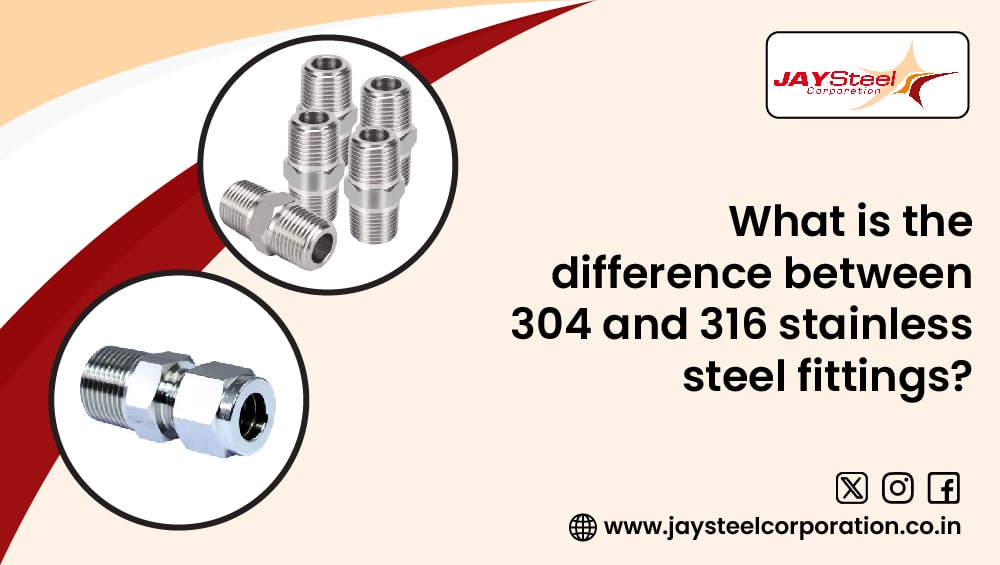At Jay Steel Corporation, we understand how key it is to choose the accurate material for your piping and industrial procedures. As a certified and authenticating manufacturer (ISO 2015, ISO 2018, PED EU, and FIEO), we manufactured 304 stainless steel fittings and 316 stainless steel fittings that comply with strict national and international quality standards.
An ordinary question we hear from clients is:
“What is the difference between the 304 and 316 stainless steel fittings?”
This blog will help you understand the key gaps, gains, corrosion resistance, & best applications of these two popular stainless steel grades.
What Are Stainless Steel Fittings?
Stainless steel fittings are components used to connect sections of pipe/tube in many industries. These fittings are preferred for their:
- Durability
- Hygienic features
- High temperature tolerance
- Corrosion resistance
- Straightforward cleaning and maintenance
They are required in industries like food processing, oil & gas, water treatment, and construction. Among all SS fittings types, 304 and 316 SS remain the premier choices globally.
304 Stainless Steel Fittings: The Industry Standard
Overview of 304 Stainless Steel
304 stainless steel is one of the most broadly used SS grades in the world. It contains approximately:
- 18% chromium
- 8% nickel
This blend gives 304 steel its classic corrosion resistance and smooth finish.
Beneficial outcomes of 304 Stainless Steel Fittings:
- Cost-effective and painlessly free
- Strong and durable under most indoor and dry outdoor requirements
- Useful weldability and formability
- Smooth surface ideal for hygienic environments
- Resistant to oxidation and most household chemicals
Applications of 304 Stainless Steel Fittings:
- Commercial and residential water pipes
- Food & beverage industry (milk, wine, beer processing)
- Kitchen equipment (sinks, dishwashers, cookware)
- Air conditioning and plumbing systems
- Structural backup in buildings
316 Stainless Steel Fittings: Developed for Harsh Conditions
Introduction to 316 SS
The key difference in 304 & 316 is the concentration of molybdenum (2-3%) in 316 SS. This elevates its corrosion resistance, notably in salty or acidic environments.
Beneficial outcomes of 316 Stainless Steel Fittings:
- Impressive resistance to chlorides, saltwater, and industrial chemicals
- Maintains capital and seeming in extraordinary temperatures
- Long-lasting in coastal and industrial zones
- Low maintenance, reduces long-term engaged costs
- Efficient for sterile environments (labs, cleanrooms)
Applications of 304 and 316 Stainless Steel Fittings:
316 Stainless Steel is preferred in:
- Marine and shipbuilding industries
- Coastal infrastructure
- Pharmaceutical and chemical industries
- Petrochemical and offshore platforms
- Medical equipment and surgical instruments
- Microbrewery and dairy pipelines with bold cleaners
Corrosion Resistance: 304 vs 316
Why Does Corrosion Resistance Matter?
Corrosion not only damages the outward look of stainless steel, it further compromises its mechanical properties. It can lead to leaks, contamination, or procedure failure — costly and dangerous in critical sectors.
Corrosion Resistance 304 vs 316 Stainless Steel Fittings: A Quick Comparison
| Property | 304 Stainless Steel | 316 Stainless Steel |
| Resistance to Salt/Chlorides | Moderate | Excellent |
| Performance in Chemical Exposure | Good | Outstanding |
| Marine Environment Suitability | Limited | Highly Suitable |
| Cost | Lower | Higher (due to molybdenum) |
| Lifespan in Harsh Conditions | Moderate | Long-term |
Note: If you work in an environment with chemicals, salt, or moisture, 316 stainless steel fittings are worth it to complete.
Difference Comparing 304 & 316 SS Fittings
Let’s understand the exact difference between 304 & 316 stainless steel fittings which includes:
- CC: 316 includes molybdenum; 304 does not.
- Resistance to Corrosion: 316 is optimal, largely in marine and chemical environments.
- Cost: 304 is more expected cost-cordial; 316 is premium.
- Applications: 304 fits natural use; 316 is created for challenging environments.
Nevertheless unsure? Let our experts at our firm guide you. We offer a free talk to help you pick the excellent stainless steel position for your project.
Stainless Steel Fittings Types at Jay Steel Corporation
We manufacture and supply a wide range of stainless steel fittings types for industries worldwide, including:
- Elbows (90°, 45°)
- Tees and Crosses
- Reducers (Concentric, Unusual)
- Threaded and Socket Weld Fittings
- Buttweld Fittings
- Nipples, Couplings, Caps
- Flanges (Slip-on, Blind, Weld Neck, etc.)
- Customized fittings as per drawing/specifications
Any product is inspected for quality and performance, meeting standards such as ASTM, ASME, DIN, and EN.
Choosing the Precise Fittings: Skilled Person’s Counsel from Our Corporation
Selecting relative to 304 vs 316 stainless steel fittings depends on:
- Sustainable Requirements: Salty, humid, or acetous? Go with 316.
- Financial plan Requirements: Limited funds? 304 still offers strong performance.
- Industry Hindrances: Some sectors require 316 for regulatory compliance.
We don’t just sell products — we provide construction support, material arrangement guidance, and on-time delivery across global markets.
Conclusion: Choose Us for Quality and Talent
When choosing between 304 and 316 stainless steel fittings, you’re deciding on long-term value, safety, and step performance. With over a decade of knowledge and international certifications like ISO 2015, ISO 2018, PED (EU), and FIEO, Jay Steel Corporation delivers fittings you can feel.
Get in touch today for your free discussion and let us help you go with the right stainless steel solution for your project.



